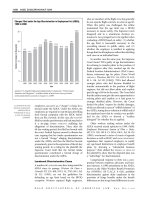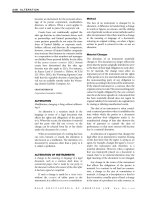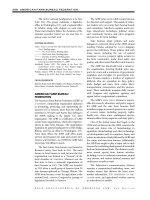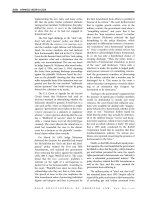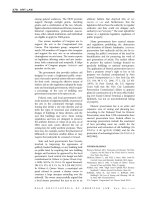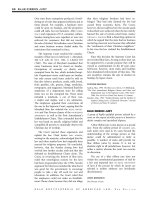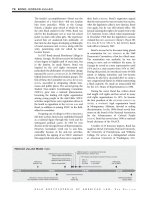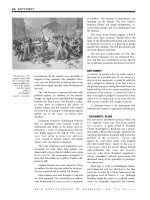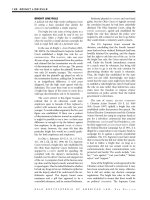Gale Encyclopedia Of American Law 3Rd Edition Volume 3 P27 pptx
Bạn đang xem bản rút gọn của tài liệu. Xem và tải ngay bản đầy đủ của tài liệu tại đây (217.02 KB, 10 trang )
injury and some property damage after their
cars collided. Under the rules governing plead-
ing in most courts, the woman would be
required to assert a demand for money damages
for the same accident in her answer to the man’s
complaint or she would lose the right to sue on
that claim. If the man also happens to be a
neighbor who borrowed the woman’s chain saw
and never returned it, the woman could
demand return of the saw as a counterclaim
or she could wait and sue the man for that at
some other time. She might decide to wait in
order to sue in a different court or because she
does not want to argue the different circum-
stances of both claims before the same jury.
A defendant usually cannot make a coun-
terclaim if it is not possible to make the same
claim by starting a lawsuit. For example, a
lawsuit to collect on a claim cannot be started
after the period of time allowed by a
STATUTE OF
LIMITATIONS
has run out. In certain situations,
however, a defendant may assert an expired
cause of action as a counterclaim. This proce-
dure, allowed for reasons of fairness and justice,
is called equitable recoupment. The court may
reduce the plaintiff’s money damages up to the
amount of the defendant’s counterclaim, but
the defendant will not be allowed an affirmative
recovery of money over and above the amount
to which the plaintiff may be entitled.
CROSS REFERENCE
Set-off.
COUNTERCLAIMS AND SETOFFS
AGAINST SOVEREIGNS
A comprehensive term for the vulnerability of a
foreign government to retaliatory suits against it
arising out of a lawsuit that it commences against
a party.
The Federal Foreign Sovereign Immunities
Act (28 U.S.C.A. § 1602 et seq. [1976]) provides
that, in any action initiated by a foreign state or
in which a foreign state intervenes, such a state
is not afforded immunity regarding any coun-
terclaim for which no immunity would have
been granted if such aclaim had been brought in
a separate action aga inst the foreign state. In
addition, a foreign state is not entitled to
immunity in cases involving counterclaims that
arise out of the transaction that is the subject
matter of the foreign state’s claim, or to the
extent that the counterclaim does not seek relief
that is in excess of, or different from, the type
sought by the foreign state.
The Foreign Sovereign Immunities Act
codified the general rule that when a foreign
government brings suit, it is deemed to have
submitted to the court’s jurisdiction and waives
its immunity to the extent that a counterclaim
arising out of the same transaction or to the
extent that the counterclaim, when used
defensively in the form of a setoff, is not in
excess of the amount of the foreign state’s
claims.
A foreign nation that is a
PLAINTIFF in an
action brought before a court of another nation
is not barred in appropriate cases from invoking
the act of state doctrine to preclude a counter-
claim against it. This doctrine provides that, as a
general rule, the acts of one foreign state
committed within its own boundaries or
territories are not reviewable by the courts of
another nation.
CROSS REFERENCES
International Law; Set-off.
COUNTERFEIT
To falsify, deceive, or defraud. A copy or imitation
of something that is intended to be taken as
authentic and genuine in order to deceive another.
A counterfeit coin is one that may pass for a
genuine coin and may include a lower denomi-
nation coin altered so that it may pass as a
higher denomination coin.
COUNTERFEITING
The process of fraudulently manufacturing, alter-
ing, or distributing a product that is of lesser value
than the genuine product.
Counterfeiting is a criminal offense when it
involves an intent to defraud in passing off the
counterfeit item. The law contains exemptions
for collector’s items and items that are so
obviously dissimilar from the original that a
REASONABLE PERSON would not consider them
real. However, making a poor copy is no
defense if the intent to defraud exists.
Counterfeiting most commonly applies to
currency and coins. It is illegal to manufacture,
possess, or sell equipment or materials for use
in producing counterfeit coins and currency.
Federal law also prohibits producing counterfeit
postmarks, postage stamps, military papers, or
GALE ENCYCLOPEDIA OF AMERICAN LAW, 3RD E DITION
248 COUNTERCLAIMS AND SETOFFS AGAINST SOVEREIGNS
government SECURITIES. Counterfeiting also
applies to the fraudulent manufacture and sale
of other items, such as computer software, CDs,
consumer products, airplane parts, and even
designer dresses. An increase in this type of
counterfeiting has led to a strengthening of
INTELLECTUAL PROPERTY laws worldwide. Counter-
feiting or conspiracy to distribute counterfeit
goods can lead to state or federal criminal
charges. Civil lawsuits also can result from
allegations of counterfeiting.
Coins and Currency
Counterfeit coins appeared within a cen tury of
the first legitimate coins, which appeared in
about the seventh century
B.C. The severity of
the punishment for counterfeiting (deat h, in
many cultures) and the difficulty of creating
counterfeit coins that did not include some
metal of value (and therefore cost a significant
amount to produce) kept the practice in check.
However, counterfeiting flourished after the
development of paper money in about
A.D.
1650, especially in American colonies where
counterfeit bills and even coins were sometimes
more common than genuine ones. Counter-
feiters had honed their skills so much that when
the United States issued its first federal coins
in the 1780s, the government hired an
ex-counterfeite r to cut the dies. Counterfeiting
boomed again during the
CIVIL WAR, when the
United States issued its first paper money.
For many decades, the skills and equipment
that are needed to create counterfeit money
confined the practice to a few professionals, and
the
SECRET SERVICE, the branch of the TREASURY
DEPARTMENT
that is charged with enforcing
counterfeiting laws, discovered most co unter-
feiters before the money leaked into circulation.
But in the late twentieth century, with the
availability of new technologies, such as color
copying and electronic reprographics, more
counterfeit schemes emerged. The
DEPARTMENT
OF THE TREASURY
estimated that $25 million
worth of counterfeit bills were pas sed off in
fiscal year 1994. Further damaging U.S. currency
was a flood of fraudulent $100 bills on the world
market. The Secret Service believes that from
the early to mid 1990s, as much as $10 billion
worth of nearly perfect counterfeit $100 bills
were circulating internationally. It believes that
the bills were printed on a press that is similar
to those used by the U.S. Treasury and that
had been sold to Iran in the 1970s. In 2002
authorities seized $130 million in fraudulent U.S.
notes worldwide before they were circulated,
and detected $44.3 million in spurious U.S.
currency after it had passed into unwitting
A fan displays both a
counterfeit (top) and
an actual ticket to the
opening game of the
1996 World Series.
Counterfeiting laws
apply to a wide
variety of products,
not just currency.
AP IMAGES
GALE ENCYCLOPEDIA OF AMERICAN LAW, 3
RD E DITION
COUNTERFEITING 249
hands. But according to the Secret Service, the
amount of fake money circulating has been fairly
constant over recent decades, and only one or two
notes in every 10,000 are counterfeit.
The increase in counterfeiting prompted
Congress to pass the Counterfeit Deterrence Act
of 1992 (18 U.S.C.A. § 471 note) to increase
penalties. Prior to the enactment of new law, it
was not a criminal act to manufacture counter-
feit U.S. currency abroad. The law also
instructed the Department of the Treasury to
redesign paper money in order to make it more
difficult to reproduce. In 1996 the first new
currency was released. The bills’ portraits were
increased in size and moved to the left, to make
room for watermark miniatures of them.
Treasury officials believe that the watermark
and the use of color-shifting inks make the
currency nearly impossible to reproduce with
current technologies.
Other Items
Counterfeiting also applies to reproductions of
packaging when the intent is to defraud or to
violate protections under trademark, copyright,
or patent laws. It is estimated that U.S.
companies lose $8.1 billion annually in overseas
business owing to violations of intellectual
property laws. Increasing the enforcement of
trademark and copyright law to discourage
counterfeiting has been a focus of U.S. trade
negotiations, both with individual countries and
during the Uruguay Round of the international
GENERAL AGREEMENT ON TARIFFS AND TRADE, Pub. L.
No. 103-465, 108 Stat. 4809 (1994).
Disputes over counterfeit CDs and computer
software have been at the center of U.S. trade
conflicts with China for several years. Software
manufacturers claim that 98 percent of the
software used in China, including that used by
the government, was illegally copied. Other
goods that are distributed under false trade marks
include cereal, razor blades, and soap. Under
pressure from the United States, China strength-
ened its copyright and trademark laws in 1993.
Lax enforcement resulted in a new trade
agreement in 1995, which was designed to give
U.S. manufacturers greater access to Chinese
markets. Nevertheless, counterfeiting in China
remains rampant.
Although most counterfeiting allegations are
brought through the criminal courts, counter-
feiting that violates patent, trademark, or
copyright laws has resu lted in civil lawsuits.
For example, in 1994, a Paris court found that
designer Ralph Lauren had copied a tuxedo
dress pattern from Yves Saint Laurent’s collec-
tion and ordered Lauren to pay his competitor
$386,000 in damages.
Punishment
Under federal law, counterfeiting is a class C
felony, punishable by up to 12 years in prison
and/or a fine of as much as $250,000. State laws
also establish penalties for counterfeiting.
FURTHER READINGS
Glaser, Lynn. 1968. Counterfeiting in America: The History of
an American Way to Wealth. New York: Potter.
“Know Your Money: How to Detect Counterfeit Money.”
2008. Washington, D.C.: U.S. Secret Service. Available
online at />shtml; website home page:
(accessed September 1, 2009).
The Economic Impact of Counterfeiting and Piracy. 2007.
Paris, France: Organisation for Economic Co-operation
and Development.
COUNTEROFFER
In contract law, a proposal made in response to an
original offer modifying its terms, but which has
the legal effect of rejecting it.
A counteroffer normally terminates the
original offer, but the original offer remains
open for acceptance if the counteroffer ex-
pressly provides that the counteroffer shall not
constitute a rejection of the offer.
The
UNIFORM COMMERCIAL CODE (UCC)—a
body of law adopted by the states that governs
commercial transactions—modifies this princi-
ple of contract law with respect to the sale of
goods by providing that the “additional terms
are to be construed as proposals for addition to
the contract.”
COUNTERSIGN
The inscription of one’s name at the end of a
writing, done by a secretary or a subordinate, to
attest to the fact that such a writing has been
signed by a principal or a superior, thereby
vouching for the genuineness of the signature. To
write one’s name at the end of a document—in
addition to the inscription of a name by
another—to attest to the authenticity of the
signature.
GALE ENCYCLOPEDIA OF AMERICAN LAW, 3RD E DITION
250 COUNTEROFFER
COUNTY
A political subdivision of a state, the power and
importance of which varies from one state to
another.
A county is distinguishable from a city or
MUNICIPAL CORPORATION, since a municipal cor-
poration has a dual character, both public and
private, while a county is established by the state
and is considered to be an agency there of.
Through
HOME RULE, a municipality may make
certain decisions on matters of local concern,
while a county is controlled by the state and
does the work of state administration.
In the state of Louisiana, a state political
subdivision is known as a parish. Comparable to
counties, parishes have no independent exis-
tence apart from the state but possess only such
authority as the state grants them.
Status
The state constitution determines the proce-
dures for the formation of a county. Certain
states require a specific minimum size popula-
tion or property value before a county is
created. A county government that is too small
can be either completely abolished or subject to
a consolidation plan designed to merge urban
and rural areas. Conversely, a county that
becomes too large or diverse follow ing an
extended period of development can be divided
by the state to form a new county.
The principle of
SOVEREIGN IMMUNITY permits
states to refuse to allow anyone to sue them.
This doctrine protects counties from legal action
to the same extent that the states they exist in
are so protected. States and counties can only be
sued where state law specifically permits it.
Boundaries
Ordinarily, the boundaries of a county are set by
the state legislature. If a boundary is marked by
a stream or river, the county extends to the
center and rema ins there from the time of the
county’s creation, even if the stream subse-
quently changes course. When a lake is the
boundary, the county line ordinarily extends to
the bank or the low water mark. A boundary
that is on the ocean extends to the three-mile
limit offshore.
State law provides for the revision of the
boundaries of countie s. Certain state statutes
proscribe the creation of a new county line too
close to an already existing county seat.
Ordinarily voters can petition for the expansion
or division of a county where populati on and
commercial growth justify it. Although citizens
have no absolute right to prevent the alteration
of county lines by state legislatures, the legisla-
ture cannot change boundaries for the purpose
of diluting the voting power of some of the
citizens in an election.
The state retains power to designate special
districts for purposes of irrigation, flood
control, fire protection, or library services,
which do not affect the makeup of existing
counties.
Government
The government of a county is located at the
county seat, a city or town where court sessions
are held and duties are performed by county
officers. The county board, comprised of public
officials who are elected or appointed to
serve on it, is the body that manages the
government of the county. Other county
officials include sheriffs, clerks, surveyors, and
commissioners responsible for certain areas
such as highways and
HUMAN RIGHTS.
The state gives counties express authority to
purchase and sell property and to raise funds
from taxes, licenses, or bond issues. Counties
have state-granted authority to make provisions
for public health, safety, welfare, and morals of
its residents through the enactment and en-
forcement of ordinances and regulations. The
state, however, has the authority to make the
decision whether to create courts on the county
level or to use counties to designate intrastate
judicial districts.
COUPON
A certificate evidencing the obligation to pay an
installment of interest or a dividend that mu st be
cut and presented to its issuer for payment when it
is due.
Coupons are usually attached to a docu-
ment, such as a
PROMISSORY NOTE, bond, share
ofstock, or a bearer instrument. A co upon is a
written contract for the payment of a definite
amount on a specified date according to the
terms of the main document from which it
must be separated for presentation for payment.
Each coupon represents a separate promise by
its issuer to pay its holder on the
DUE DATE.
Failure to do so will support a
CAUSE OF ACTION
for breach of contract.
GALE ENCYCLOPEDIA OF AMERICAN LAW, 3RD E DITION
COUPON 251
COURSE OF DEALING
A clearly recognizable pattern of previous conduct
between parties to a business transaction.
The course of dealing between parties to an
action is examined by a court in ascertaining
what the parties intended when they entered
into a contract. The supposition is that the
parties drew up the contract in view of the
customary manner in which business had been
transacted prior to the signing of the contract.
In a breach-of-contract action, evidence of
the course of dealing is admissible in order to
interpret ambiguities in the contract, but not to
effectuate an alteration or contradiction of the
contract’s provisions. A term that was seemingly
unambiguous when the contract was entered
into might subsequently prove to be problematic.
Course of dealing is distinguishable from
both
COURSE OF PERFORMANCE and TRADE USAGE.
Course of performance refers to a pattern of
conduct that occurs subsequent to approval of
the contract terms. Trade usage entails behavior
that is the standard of conformity for a majority
of businesses engaged in a particular business or
commercial venture.
Course of dealing safeguards the expecta-
tions of the parties and augments the certainty
of their transactions, based upon their prior
experiences with each other.
The concepts of course of dealing, course of
performance, and trade usage in the context of
contract law are derived largely from the work
of Linton Corbin, who did not believe that
courts should be bound by the so-called
FOUR
CORNERS
of a contract or to the “plain meaning”
to those terms. Corbin was instrumental in the
drafting of the
UNIFORM COMMERCIAL CODE
(UCC), which governs commercial agreements
and transactions in most states. The UCC
defines course of dealing in its general provi-
sions (U.C.C. § 1-205). The term applies, for
example, to the laws governing contracts for the
sale of goods, negotiable instruments, and
SECURED TRANSACTIONS.
COURSE OF EMPLOYMENT
As set forth in workers’ compensation acts, the
time, place, and conditions under which an on-
the-job accident occurs. The performance of an act
that an employee might prudently do while in the
appropriate area during working hours.
In the event that an employee causes an
injury to another or another’s property, it is
necessary to ascertain whether the employee was
acting within the course of employment. The
employer is legally responsible for the damages if
the employee caused them while performing a
job. If a driver for a transportation firm is
involved in an accident with a pedestrian, for
example, the pedestrian can sue both the driver
and the firm. Under the doctrine of
RESPONDEAT
SUPERIOR
, an employer can be held liable for a
tort, a civil wrong other than breach of contract,
committed by an employee operating within the
scope of the employee’s employment.
Workers’ compensation laws require the
payment of compensation from the employer to
the employee in conformity with a schedule for
a particular category of injury, provided that the
employee is injured during the course of
employment. The course of employment
encompasses the actual period of employment
and the period during which the employee,
while on the employer’s premises, prepares to
commence or to depart from work, such as by
changing clothes. Employer-sponsored recrea-
tional activities are also considered part of the
course of employment when organized, encour-
aged, or supported by the employer for business
purposes, such as the promotion of efficiency.
The test is whether the recreation inured to the
employee’s exclusive benefit or whether the
employer had some interest in the activity.
Injuries suffered by an employee while observ-
ing, participating, or traveling to or from
recreational activities sponsored in whole or in
part by the employer but conducted on the
employee’s time and off the employer’s premises
are not compensable.
Where the recreationa l activity is part of the
employee’s compensation, an injury is compen -
sable. If an employer, for business reasons,
arranges and pays for an employee to join and
participate in a social or athletic club, the
employee’s activities are an incident of the
course of emplo yment and an injury is,
therefore, compensable.
The periods during which an employee
prepares for work while at home or commutes
to his or her place of business are not within the
course of employment, and, therefore, are not
covered by workers’ compensation laws.
COURSE OF PERFORMANCE
Evidence of the conduct of parties concerning the
execution of obligations under a contract requiring
GALE ENCYCLOPEDIA OF AMERICAN LAW, 3RD E DITION
252 COURSE OF DEALING
more than one performance that is used for the
purpose of interpreting the contract’s provisions.
Course of performance refers to the system-
atic and uniform conduct in which parties
engage after they enter into a contract. The
intent of the parties in regard to the meaning of
the agreement is reliably ascertainable through
the application of course of performance only
when a contract requires a repetitive series of
performances. There must be more than one
performance, but no particular number is
required. The fewer the performances, the more
probable it is that such performances cannot
constitute a course of performance.
If a party accepts a course of performance
without objection, his or her acquiescence is
relevant to determining the meaning of the
contract. The recipient of the performance need
not expressly assent to the performance; the
lack of an objection is sufficient. Unless there
has been acceptance without objection, a party
who performs cannot benefit from the applica-
tion of course of performance.
Sometimes the acts of the parties may be
inconsistent with the pertinent contractual
language. A party may argue that the meaning
of the agreement is unequivocal—that the
course of pe rformance is inconsistent with
the contract provisions—and, therefore, that
the express terms of the contract should
predominate over the course of performance.
The prevailing view is that no contractual
term is so clearly defined that a party cannot
demonstrate the way in which the parties
actually applied it. Purs uant to the admissibility
of the course of performance, and assuming
that this evidence is credible, the language
selected by the parties has the meaning that they
had ascribed to it, and, therefore, no inconsis-
tency exists between the contract provisions and
the course of performance.
A minority of jurisdictions hold that some
words have a plain meaning and, conse quently,
that course of performance is inadmissible to
show their meaning when they are not ambigu-
ous. Other courts reason that it is relevant to
show that there has been either a waiver, an
intentional relinquishment of a known right, or
a modification of the contract before the
application of course of performance.
The concept of course of performance in the
context of contract law, along with such
concepts as
COURSE OF DEALING and TRADE USAGE,
is derived largely from the work of ARTHUR
LINTON CORBIN
. One of the leading theorists in
the field of contract law in the twentieth
century, Corbin did not believe that courts
should be bound by a formal reading of the
“four corners” of the contract. Corbin was
instrumental in the drafting of the
UNIFORM
COMMERCIAL CODE
(UCC), which governs com-
mercial agreements and transactions in most
states. Under the UCC, courts may consider
course of performance of the parties in order to
determine, for example, whether the parties
have formed a contract for the sale or lease of
goods (U.C.C. §§ 2-208, 2A-207).
CROSS REFERENCE
Plain-Meaning Rule.
COURT
A court is a judicial tribunal established to
administer justice. It is also an entity in the
government to which the administration of justice
is delegated. In a broader sense, the term may also
refer to a legislative assembly; a deliberative body,
such as the General Court of Massachusetts, which
is its legislature. The words court, judge, or
judges, when used in laws, are often synonymous.
A kangaroo court is a mock legal proceeding that
disregards law and justice by issuing a biased,
predetermined judgment regardless of the evidence
presented before it.
Judicial courts are created by the govern-
ment through the enactment of statutes or by
constitutional provisions for the purpose of
enforcing the law for the public good. They are
impartial forums for the resolution of contro-
versies between parties who seek redress from a
violation of a
LEGAL RIGHT. Both civil and criminal
matters may be heard in the same court, with
different court rules and procedures for each.
The public has a right to attend judicial
proceedings. This right ensures that the pro-
ceedings will be conducted in a fair and
unbiased manner. Anyone who wants may
attend trials as a spectator unless a judge has
closed a courtroom for particular proceedings
in order to maintain order, to assure
DUE PROCESS
OF LAW
, or to protect a witness’s identity.
The U.S. Judicial System consists of 52
separate court systems, plus
TERRITORIAL COURTS,
in the United States. All states and the District of
Columbia have their own independent systems,
GALE ENCYCLOPEDIA OF AMERICAN LAW, 3RD E DITION
COURT 253
and the United States government maintains
federal courts throughout the country. The
federal courts and state courts are inde pendent
of each other. The federal courts are authorized
by Article III, Section 2, of the Constitution to
hear controversies that especially affect federal
interests. Sometimes the existence of two parallel
court systems in every state creates a strain and
raises important issues concerning federalism,
the relationship between the states and theUnited
States. For some of these questions, the
SUPREME
COURT OF THE UNITED STATES
makes the final
determination that is binding on everyone.
Most courts have a multilevel structure. A few
states have a two-tiered system, but the federal
government and most states use a three-tiered
model. All litigants have an opportunity to argue
their cases before a trial-level court, and subse-
quently they may be able to pursue the matter
further up through two levels of appeals courts.
In the federal court system the trial-level
court is the district court. Each state contains at
The First Virtual State Court
U
B
.S. courts have adopted various new technol-
ogies that can assist in the administration of
justice, but the state of Michigan took the most
radical step in 2002 when it authorized the creation
of the first fully functioning cybercourt in the
country. This virtual court, once fully operational,
would have allowed attorneys to file court appear-
ances, briefs, and other court documents online.
Specially trained district and circuit judges would
have served three-year assignme nts on this court.
The cybercourt in its first incarnation was to be
limited in jurisdiction to business disputes with an
amount in controversy exceeding $25,000. The court
would not use juries, as it was designed to assist
businesses that need quick resolutions of disputes,
such as those involving trade secrets. Critics pointed
out that the system would not allow judges to
examine evidence physically or even to view
evidence with any certainty, given the limitations in
viewing screen resolution in many video or real-time
communications. In addition, critics contended that
many business disputes involve issues of federal law
and diversity jurisdiction, thereby denying this court
the opportunity to hear many cases.
The Michigan Supreme Court proposed new
rules to govern the operation of the cybercourt.
These rules addressed: the filing of pleadings and
other documents via the Internet; the prevention of
tampering with electronic documents; how testimony
would be given via the Internet, videoconferencing,
or interactive video; how serving notice on parties to
a lawsuit via e-mail will work; and how court
proceedings will be made accessible to the public.
The Michigan cybercourt was supposed to be
operational by late 2002, but by 2003 it became
apparent that the legislature would not fund it.
Though no state has pursued a similar cybercourt,
many state and federal jurisdictions have since
adopted the electronic filing of documents, the
electronic scanning of hardcopy documents, and
the use of interactive television (ITV) for court
hearings. With improved video resolution, the day
may come when such an integrated cybercourt is a
reality.
FURTHER READINGS
Issenberg, Doug. 2001. “See You in Cybercourt?” Internet
World (April 1).
“Michigan Bill Will Create Cybercourt.” 2002. Associated Press
(January 9). Available online at www.ap.org (accessed
September 1, 2003).
“Michigan House Battles Over Cybercourt Funding.” Michigan
Technology News. Available online at www.mitechnews.
com/registry/technews/breakingnews.htm (accessed
July 1, 2003).
“Michigan Wants to Speed Business Dispute Resolution with
Cybercourt.” 2001. Associated Press (February 23). Avail-
able online at www.ap.org (accessed September 1, 2003).
Stephens, Gene. 2001. “Trial Run for Virtual Court.” Futurist
(November-December).
“Website of the Week.” 2002. National Law Journal
(February 11).
“Wired Future for Courtrooms.” 2001. Associated Press
(March 1). Available online at www.ap.org (accessed
September 1, 2003).
CROSS REFERENCES
Courtroom Television Network; Internet
GALE ENCYCLOPEDIA OF AMERICAN LAW, 3RD E DITION
254 COURT
least one district court, and most of these courts
have more than one judge available to try cases.
Litigants may file an appeal with the U.S. court of
appeals that has jurisdiction over that district if
they are unhappy with the lower court’s decision,
and the decision is the type that may be appealed.
The United States is divided into 13 judicial
circuits, and one court of appeals sits in each of
twelve geographical circuits. The Court of
Appeals for the Federal District sits in the
thirteenth district to hear cases formerly enter-
tained in the
COURT OF CLAIMS and the Court of
Customs and Patents Appeals, which were
abolished by the enactment of the Federal Courts
Improvement Act of 1982 (28 U.S.C.A. § 1 note).
Each court of appeals has four or more judges
who sit either as panels of three or as a whole to
review the decisions of district courts and to
review or enforce the orders of many federal
administrative agencies. If a court sits as a whole,
it is called an
EN BANC court. Litigants who lose a
cause in a court of appeals may be able to carry
the appeal to the U.S. Supreme Court.
Cases in state courts may also proceed from
the trial-level court up through appeals in an
appellate court and then to a state supreme court.
Different systems assign different functions to the
state supreme court, which is usually the court of
LAST RESORT, but this is not the case in every state.
When an issue based on the federal Constitution,
a treaty, or a federal statute is involved, the U.S.
Supreme Court may agree to hear an appeal from
the state supreme court.
The organization ofacourtand itspersonnel is
determined by the law that created that court and
by the court’s own rules. Generally, the papers for
each lawsuit must be filed with the clerk of the
court. The clerk and his or her staff organize all of
the records for the judges assigned to the court.
Each judge may have a law secretary or law clerk,
or there may be several clerks who perform legal
research and assist in the drafting of decisions,
orders, and memoranda. Court officers, court
attendants, or bailiffs are available to give
information and to maintain order and peace
around the courthouse. Interpreters may be kept
on call to translate for witnesses and parties who
do not speak English well. A county sheriff or
federal marshal has the responsibility for enforce-
ment of various judicial orders. Probation officers
are usually civilian employees who assist the court
by administering the probation system for crimi-
nal offenders and supervisecourt-ordered custody
or payments of money, especially
CHILD SUPPORT.A
court stenographer, or
COURT REPORTER,createsa
written record of proceedings word for word.
Attorneys are called
OFFICERS OF THE COURT
because they have a dual responsibility to
protect the integrity of the legal system and
pursue their clients’ claims. An attorney who
has been admitted to the bar in one state is
entitled to practice in the courts of that state but
that does not entitle him or her to practice in
the courts of another state, in a federal court, or
in the Supreme Court. In order to do so, he or
she must qualify and be sworn in separately.
A term is the time during which a court is
authorized to hear cases, and a session is one of
those periods in a term when a judge is actually
hearing cases. A regular term is one called for by
law, and a special term may be called by a judge
or other official when the circumstances
warrant it. A jury may hear a case during the
jury term while a motion for relief may be made
to the court during the motion term.Ageneral
term sometimes means the time that all of the
judges of a court sit together, or en banc, but
occasionally it refers to a single judge’s hearing
all of the cases on a particular subject.
Laws or court rules fix the particular terms
or sessions when a court is open for judicial
business. If none is fixed, a court is open at all
times. Any
JUDICIAL ACTION taken by a judge of
the court is not invalid in such circumstances
because of the time when it was taken, but it
does not necessarily mean that the courthouse
doors are unlocked 24 hours per day.
Rules of
CIVIL PROCEDURE and of CRIMINAL
PROCEDURE
regulate practice in the courts. The
rules spell out rights and the manner of
proceeding in regard to a court’s jurisdiction
and venue, the commencement of an action,
parties, motions, subpoenas, pretrial discovery,
juries, evidence, the order of a trial, provisional
remedies, judgments, and appeals.
FURTHER READINGS
Hume, Robert J. 2009. How Courts Impact Federal
Administrative Behavior. New York: Routledge.
Yackle, Larry W. 2009. Federal Courts 3d ed. Durham, N.C.:
Carolina Academic Press.
CROSS REFERENCE
Judicial.
COURT ADMINISTRATOR
An officer of the judicial system who performs
administrative and clerical duties essential to the
GALE ENCYCLOPEDIA OF AMERICAN LAW, 3RD E DITION
COURT ADMINISTRATOR 255
proper operation of the business of a court, such as
tracking trial dates, keeping records, entering
judgments, and issuing process.
A go-between for judges, attorneys, and
clients, the court administrator essentially runs
the court’s business. The behind-the-scenes
work of this position ranges from scheduling
trial dates to handling all official correspon-
dence. Courts produce volumes of paper; the
administrator’s office processes them, accepting
lawsuit filings, authenticating court documents,
and issuing writs and summonses. Formerly
known as the clerk, the post has evolved since
the mid-1980s as technology has streamlined
some elements of the justice system.
State and county administrators do essen-
tially the same job. Unlike those in past decades,
nearly all administrators in the early 2000s
are appointed by judges. Judicial appointment
has helped take politics out of this powerful
position, and by the mid-1990s, only the state of
Montana still preserved an elected post for its
court administrator. State administrators oper-
ate under statutory authority that entitles them
to execute court affairs and provides an annual
staff budget. County-level administrators are
generally chosen by committee, with funding for
their offices commonly generated by court fees.
Contemporary trends in court management
have reshaped this traditional office. Technolo-
gy has led the change: where once courts relied
entirely on paper records, computer databases
are fast becoming the norm. For example, using
computer software to track trial dates has begun
to rep lace the ancient practice of relying on the
court docket. Beyond allowing for greater
flexibility, this new method also turns the tables
on lawyers who have customarily controlled the
pace of cases. A related trend in the mid-1990s,
introduced by Minnesota, is toward uniformity:
the state’s General Rules of Practice place all
jurisdictions under the same uniform rules,
aiming to save time in scheduling as well as
ensuring that local attorneys have no advantage
over out-of-state attorneys.
COURT COMMISSIONERS
Persons appointed by a judge to find facts, to hear
testimony, or to perform a specific function
connected with certain types of cases.
An attorney, a judge, a retired judge, or any
person with the background necessary to com-
prehend complex legal matters may be a court
commissioner, although a court commissioner
is not a judge. The court that the court
commissioner serves ordinarily reviews his or
her decisions.
Commissioners may take testimony in
hearings to determine the validity of a will;
proceedings concerning the entry of default
judgments or stipulations; pretrial conferences
in criminal cases; or proceedings involving
family court petitions to modify alimony or
CHILD SUPPORT. State law governs the powers of
court commissioners.
COURT HAND
In old English practice, the peculiar style and form
of writing in which court records were transcribed
from the earliest period to the reign of George II,
circa 1760.
This form of Latin shorthand was character-
istically concise, strong, and absolutely uniform
even though it was handwritten. Due to the
numerous and unusual abbreviations and con-
tractions, proficiency in the art of court hand was
an important step in entering the “clerkship”
profession. Court hand imported to the ancient
record the essential quality of durability.
COURT-MARTIAL
A tribunal that tries violations of military criminal
law. It often refers to the entire military justice pro-
cess, from actual court proceedings to punishment.
First established in eighteenth-century U.S.
law, the court-martial is today the result of
tremendous modernization that has made it
similar to a trial in federal district court.
Defendants are presumed innocent until proven
guilty, accorded considerable legal protections,
and guaranteed the right to appeal. The court-
martial is governed by the
UNIFORM CODE OF
MILITARY JUSTICE
(10 U.S.C.A. §§ 801–940), a
federal law that Congress originally passed in
1950, but that legislators, presidents, and the
U.S. Supreme Court have since changed several
times. Significant reforms of the court-martial
now grant military defendants esse ntially the
same due process rights that are afforded
defendants in civilian courts.
The Uniform Code of Military Justice vests
in the
PRESIDENT OF THE UNITED STATES the authority
to draft and to amend the Manual for Courts-
Martial, United States (10 U.S.C.A. §§ 801-946).
This document includes a number of procedural
rules in the military justice system, including the
GALE ENCYCLOPEDIA OF AMERICAN LAW, 3RD E DITION
256 COURT COMMISSIONERS
Rules for Courts-Martial and Military Rules of
Evidence. These rules are practiced by judge
advocates, who serve as the attorneys in the
military justice system. Whereas many of the
rules are similar or analogous to procedural rules
in the civil justice system, such as the Federal
Rules of
CRIMINAL PROCEDURE and the FEDERAL
RULES OF EVIDENCE
, the military rules provide
specific rights and procedures that do not have
civil counterparts. In 1998 President
WILLIAM
JEFFERSON CLINTON
approved several amend-
ments to the Manual, including those related
to pre- an d post-trial confinement, trials,
sentencing, substantive criminal offenses and
defenses, post-trial procedures, and the au-
thority of the
JUDGE ADVOCATE General.
Three levels of courts exist in the military
justice system: military trial courts, courts of
military review, and the U.S. Court of Military
Appeals. Courts-martial are handled by the
lowest courts, which are presided over by
military trial judges who are quite similar to
U.S. district court judges. These judges are
commissioned officers selected by judge advo-
cates according to rules established by Congress,
and their responsibility for individual
cases begins and ends with the court-martial
process. The military trial courts are organized by
the type of courts-martial that they address—
summary, special, and general, which reflect
increasingly serious charges and punishments.
Just as trials in civilian criminal courts are
the result of work by police officers and
prosecutors, courts-martial are preced ed by a
formal investigation. During questioning, mili-
tary suspects have the same
FIFTH AMENDMENT
right to remain silent, as do civilians, as well as
some additional rights. Civilian police officers
must read a suspect the Miranda rights at the
time of arrest. Article 31 of the Uniform Code
of Military Justice requires military investigators
to go even further: As soon as suspicion focuses
on a suspect during interrogation, they must
advise him or her of the right to remain silent.
This stringent requirement places a higher
burden on military investigators to protect
suspects’ rights, and later it can become grounds
for the dismissal of charges if it is not followed.
Military laws provide generous protections
to defendants before a case goes to trial. These
include complete pretrial discovery, allowing
defendants free access to witnesses and evi-
dence, as well as a requirement that prosecutors
reveal the names of witnesses who will be called
during all stages of the trial. In addition, the
government must provide defendants with
expert witnesses at its own expense; judges
may delay or dismiss trials if prosecutors fail to
do so. The military judge is empowered to hear
pretrial motions on a broad range of issues,
ranging from alleged violations of the defen-
dant’s constitutional rights to the admissibility
of evidence. Before the case is heard, defendants
have the choice of trial by judge or jury, and
enlisted members can request that at least one-
third of the court be enlistees. Defendants may
also elect to be provi ded with military counsel
or to hire a civilian attorney.
The court-martial closely resembles a trial in
federal court. Military judges have the same
authority as federal judges to rule on all matters
of law and to give orders to the prosecution and
the defense on such procedural matters as
arguments, motions, and challenges. Two differ-
ences are particularly significant. First, whereas
few civilian courts allow jurors to pose questions
to witnesses, military courts have long permitted
the practice. Jurors may submit written ques-
tions, which both the prosecution and the
defense read in order to prepare any possible
objections, which also must be in writing. The
judge then decides which questions to allow.
Second, military judges have a greater duty than
do federal judges to review a defendant’s entry
of a guilty
PLEA. This duty is designed to protect
defendants from pleading guilty because of
coercion, which could be more likely in the
military because of its strict code of discipline
and obedience to authority.
MILITARY LAW
requires judges to reject the plea at any stage
of a proceeding if any hint of coercion is found.
The right to appeal convictions in military
courts is different from that in civilian courts.
Options for appeal are determined by the
type of court-martial: Summary court-martial
convictions, which are for lesser offenses, offer
only the right to appeal to the commander who
convened the court, and to make a further
petition for review to the judge advocate general.
Convictions in special and general courts-martial
can be appealed to higher authorities, but the
type of sentence handed down also governs a
convicted party’s rights. If the sentence is less
than six months’ confinement or a bad-conduct
discharge, the case is reviewed by a legal officer in
the convening authority’s staff judge advocate’s
office, with no further appeals other than a right
to petition the judge advocate general.
GALE ENCYCLOPEDIA OF AMERICAN LAW, 3RD E DITION
COURT-MARTIAL 257
